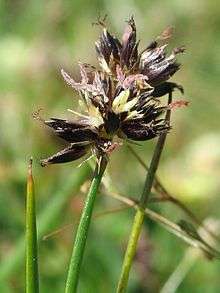Juncus phaeocephalus
Juncus phaeocephalus, the brown-headed rush, is native mostly along the coast of California, north to Oregon and Washington.[1] It grows in moist seeps and shallow wet soil.
| Juncus phaeocephalus | |
|---|---|
 | |
| Juncus phaeocephalus var. phaeocephalus | |
| Scientific classification | |
| Kingdom: | Plantae |
| Clade: | Tracheophytes |
| Clade: | Angiosperms |
| Clade: | Monocots |
| Clade: | Commelinids |
| Order: | Poales |
| Family: | Juncaceae |
| Genus: | Juncus |
| Species: | J. phaeocephalus |
| Binomial name | |
| Juncus phaeocephalus | |
Distribution
Juncus phaeocephalus is native to the coastlines of California. It is distributed in meadows and borders of swamps and coastal regions from Los Angeles County and Mendocino County to Oregon and Washington.[2]
- Habitat and ecology
Juncus phaeocephalus grows along the coast in sand dunes, marshes and sloughs. Some of them also grow inland in wet grassy meadows, bogs, and along lakes and streams, such as in the Peninsular Ranges and Transverse Ranges of Southern California.[3][4] Its creeping rhizomes can spread across moist soil. This perennial plant can grow in elevations less than 2,200 metres (7,200 ft) high.
Description
Juncus phaeocephalus is perennial with creeping rhizomes. It has flattened stems that are two-edged and can grow up to 1.5 feet (0.46 m) tall. Its leaves are shorter than its flowering stems. Brown-head Rush can be easily mistaken from sedges or irises because of its stems and leaves.[5] These plants have many flowers that exhibit a brownish color with one to several spherical heads at the ends of the stem.
- Morphology
This plant is perennial and can grow up to 1.5 feet (0.46 m) tall. They appear as herbs and erect. Its stems are flat, erect and leafy. They arise from stout elongated rootstocks.
Its leaves are 0.5 to 1.5 lines wide and are ribbed by transverse septa. The septa of the leaf-blades are not complete. It does not have any ligule. The bases of the leaves are overlapping. The blades are flat with edges towards the stem. Their tips are often fine-pointed.[6]
- Inflorescence
Its inflorescence appears terminal, having the lowest bract of the inflorescence not appearing as a continuation of the stem.
The flowers of this plant are in heads. The flower's heads can have one or many. It has 6 stamens. Its perianth is dark brown in color, and is about 4 to 6 mm long, with anthers longer than the filaments. The flowers are widely lanceolate. Its style is long and the stigmata are exserted.
This plant produces many seeds. These ovoid seeds are about 0.6 mm in size.
Varieties
Juncus phaeocephalus is a variable species in which several subspecific varieties have been characterized mainly on its branching patterns of the inflorescences.
Named varieties include:[7]
- J. phaeocephalus var. phaeocephalus — plants with few, many-flowered heads.
- J. phaeocephalus var. paniculatus— plants with many, few-flowered heads.
- J. phaeocephalus var. glomeratus — plants with many, many-flowered heads.
Poisonous plant
According to the tests made on the plants at the Chemistry Laboratory of the California Department of Food and Agriculture, Juncus phaeocephalus has as much as 30 ppm of hydrocyanic acid present in the plants. Due to its volatile nature, the concentration of this chemical might be greater before the actual testing was made.
One actual case of hydrocyanic acid poisoning from a common rush occurred in California. In December 1958, two dairy heifers were found dead on a farm land near Petaluma, Sonoma County. The heifers died due to consumption of Juncus phaeocephalus plants.[8] Juncus phaeocephalus grows with Verbena spp., Mimulus guttatus, Eleocharis macrostachya and Agrostis densiflora.[9]
References
- USDA— Juncus phaeocephalus . 2.12.2013
- Jepson, Willis (1957). A Manual of the Flowering Plants of California. Berkeley and Los Angeles: University of California Press. pp. 1238. ISBN 9780520006065.
A Manual of the Flowering Plants of California.
- Calflora . 2.12.2013
- Parikh, Anuja; Nathan Gale (1998). "Vegetation monitoring of created dune swale wetlands, Vandenberg Air Force Base, California". Ecological Restoration. 6 (1): 83–93. doi:10.1046/j.1526-100x.1998.06111.x.
- Todd Keeler-Wolf; Allan A. Schoenherr; Michael G. Barbour (2007). Michael G. Barbour (ed.). Terrestrial Vegetation of California (Third ed.). Berkeley, Los Angeles, California: Regents of the University of California. ISBN 978-0-520-24955-4.
- Bruce G. Baldwin; Douglas H. Goldman; David J Keil; Robert Patterson; Thomas J. Rosatti, eds. (2012). The Jepson Manual: Vascular Plants of California (Second ed.). Berkeley, California: Regents of the University of California. ISBN 9780520253124.
- Thomas, John (1961). FLORA of the Santa Cruz Mountains of California. Stanford, California: Stanford University Press. p. 434. ISBN 9780804718622.
- Thomas C. Fuller; Elizabeth McClintock (1986). Advisory Editorial Committee (ed.). Poisonous Plants of California. Berkeley, Los Angeles, London: University of California Press. pp. 433. ISBN 9780520055698.
- Edward Sanford Harrison (1892). History of Santa Cruz County, California. San Francisco, California: Pacific Press Publishing Company.